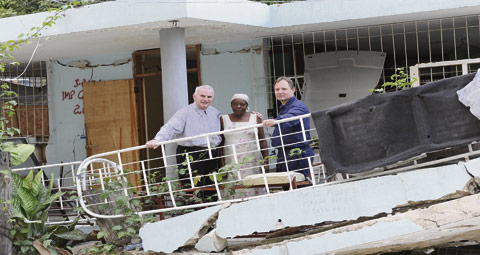BY No Author | January 14 | ![]() 0 COMMENTS
0 COMMENTS ![]() print
print

‘I wondered how any germs or bacteria could survive…’
— Cardinal O’Brien, in Haiti with SCIAF, gives a first-hand account of the devastation one year on from the earthquake
I flew out on Thursday January 6 to Haiti not knowing exactly what to expect. I was joined by Paul Chitnis, chief executive of SCIAF and photographer Paul McSherry, realising that this would be an important visit—especially for the people of Haiti to let them know what SCIAF had been giving to Haiti for the past 25 years and to see how that money has been spent; and especially to consider what had been achieved over the past year since the terrible earthquake of January 12 2010.
We flew into the capital city of Haiti, Port-au-Prince, last Friday. We were received warmly by the Apostolic Nuncio Archbishop Bernadito Auza, at the airport and our drive to the Apostolic Nuniciature where I was staying was more than a culture shock!
During the afternoon, we were taken through the city to visit some of the scenes of devastation including the cathedral, National Palace and various desolate areas where people try to live and eke out an existence.
The iconic sight of the cathedral, never to be rebuilt, came into view. Its stained glass, Stations of the Cross and ornaments were all looted in the aftermath of the quake to sell for food. We also saw the devastated house of the Archbishop Miot who also lost his life in the disaster. Outside the cathedral is the isolated figure of the crucified Lord to which local people come fervently to pray.
In front of the Presidential Palace were again makeshift homes but also posters from the recent general election campaign still adorning the lawns. From time to time there were hands outstretched for help from maimed victims of the disaster crying out for help from the hovels that were their homes.
We visited some of these houses on our way back to the Nunciature. I vividly remember Rosalene Calixte (67) showing us her ‘home.’ It was in fact a house that had collapsed in the earthquake. The previous occupants had fled or died and she was now squatting in the remains of the rubble. All around were warnings about the cholera epidemic but I wondered how any germs or bacteria could survive in that place let alone human beings.
We left Port-au-Prince with heavy hearts on Saturday morning to see the work of SCIAF in the north of Haiti. As we left the airport by our small plane for a short hop over the mountains, we flew over Port-au-Prince and could see the extent of the devastation and the thousands of temporary shelters set up by those who had lost their homes. Having landed on a field with a bump, we drove by car for one hour along dirt tracks to the parish house where we were given a warm welcome by the parish priest and the student undergoing pastoral experience with him, Fr Sylvain and Anaclet. Both were from the Democratic Republic of Congo and were members of the Congregation of the Immaculate Heart of Mary, a Belgian congregation of Missionaries.
We did not have much time to relax. Almost immediately we were taken to meet the Felix family about another hour’s journey along pot-holed tracks to their family home. The Felix family is one of 750 members of the GADRU organisation supported by SCIAF that enables small farmers to produce better crops, vegetables and fruit for their own use or for sale in local towns to provide much needed extra income to help with the education of their children.
We were thanked by the Apostolic nuncio for the donations given to projects such as these but he reminded us that 85 per cent of people live below the poverty level in Haiti.
On the Feast of the Baptism of Our Lord, I concelebrated two beautiful Masses: in the parish church of Mombin dedicated to Our Lady of Deliverance at 7.30am (homily above right); and then after another one and half hours journey in one of the out-stations at Grande Savane. For them, these liturgies were the centre point of the week although, of course, there only being one priest in the parish Masses were celebrated less regularly.
Here at home we grumble about changes to Mass times, or places where Masses can be cancelled in our parishes, without much thought of those so spiritually deprived as well as materially deprived. I know that it was with heavy hearts that I left this little area of Haiti that had not been disturbed by the earthquake but was growing in their faith and ability to help one another through the initiatives of SCIAF. I hope to bring you my impressions of what followed in the days ahead in the capital city as we returned there on Monday morning.
Picture: Paul McSherry











